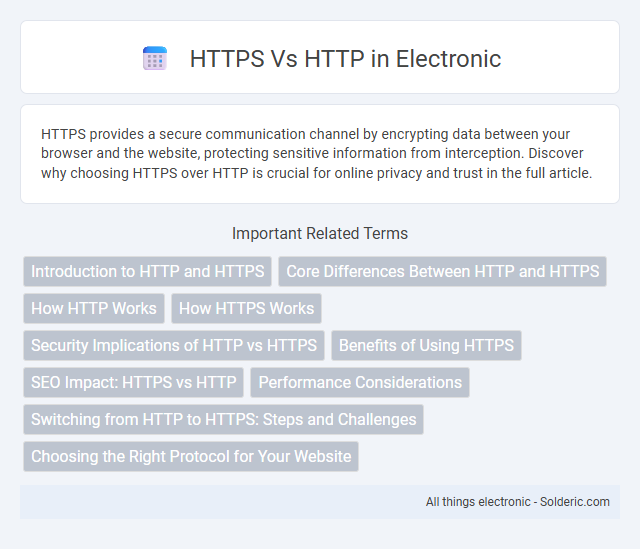HTTPS provides a secure communication channel by encrypting data between your browser and the website, protecting sensitive information from interception. Discover why choosing HTTPS over HTTP is crucial for online privacy and trust in the full article.
Comparison Table
| Feature | HTTP | HTTPS |
|---|---|---|
| Full Form | HyperText Transfer Protocol | HyperText Transfer Protocol Secure |
| Security | Not Encrypted | Encrypted with SSL/TLS |
| Port Used | Port 80 | Port 443 |
| Data Integrity | Not Guaranteed | Ensured by SSL/TLS |
| Authentication | No Authentication | Website Identity Verified |
| Use Case | Public Information | Secure Transactions, Private Data |
| SEO Impact | Lower Ranking | Higher Ranking in Search Engines |
| Speed | Faster (no encryption overhead) | Slightly Slower (encryption overhead) |
Introduction to HTTP and HTTPS
HTTP (HyperText Transfer Protocol) is the foundational protocol for transferring data on the web, enabling communication between browsers and servers. HTTPS (HyperText Transfer Protocol Secure) enhances HTTP by incorporating SSL/TLS encryption, ensuring data confidentiality, integrity, and authentication during transmission. Using HTTPS safeguards your online interactions from interception, making it the preferred protocol for secure web browsing and data exchange.
Core Differences Between HTTP and HTTPS
HTTP (HyperText Transfer Protocol) transmits data in plaintext, making it vulnerable to interception and attacks. HTTPS (HyperText Transfer Protocol Secure) uses SSL/TLS encryption to secure data transmission, ensuring confidentiality and data integrity. The core difference lies in HTTPS providing authentication through digital certificates, which verifies the website's identity, unlike HTTP.
How HTTP Works
HTTP (HyperText Transfer Protocol) functions as a request-response protocol where your browser sends an HTTP request to a web server to access resources like web pages or files, which the server then responds to with the requested data. This process occurs over TCP/IP connections, typically using port 80, and transmits information in plaintext, making it vulnerable to interception or tampering. Understanding how HTTP works highlights the importance of HTTPS, which adds encryption layers to secure your data during transmission.
How HTTPS Works
HTTPS secures data transmission by encrypting information using SSL/TLS protocols, creating a secure tunnel between the client and server. This encryption ensures data integrity, confidentiality, and authentication, preventing interception and tampering by attackers. The process begins with a TLS handshake, where cryptographic keys are exchanged to establish a secure connection before any data is transmitted.
Security Implications of HTTP vs HTTPS
HTTPS encrypts data between your browser and the server using TLS, ensuring that sensitive information like passwords and credit card details remain secure from hackers and eavesdroppers. HTTP transmits data in plain text, making it vulnerable to interception, man-in-the-middle attacks, and data tampering. Choosing HTTPS protects your privacy, boosts website trust, and improves search engine rankings due to enhanced security protocols.
Benefits of Using HTTPS
HTTPS encrypts data transmitted between the user's browser and the web server, ensuring secure communication and protecting sensitive information from hackers. It significantly improves website trust and credibility by displaying security indicators like the padlock icon in browsers, which increases user confidence. Search engines favor HTTPS sites, resulting in better SEO rankings and higher organic traffic compared to non-secure HTTP sites.
SEO Impact: HTTPS vs HTTP
HTTPS significantly enhances SEO performance by improving website security, which is a key ranking factor for search engines like Google. Websites using HTTPS benefit from better trust signals and higher click-through rates, boosting overall search engine rankings compared to HTTP sites. The encryption provided by HTTPS also protects user data, reducing bounce rates and increasing user engagement, which positively influences SEO metrics.
Performance Considerations
HTTPS uses TLS encryption which introduces a slight overhead compared to HTTP, potentially affecting initial connection speeds. Modern protocols like HTTP/2 and HTTP/3, supported by HTTPS, improve overall performance through multiplexing, header compression, and reduced latency. Your website benefits from faster, more secure connections despite the minimal performance trade-offs associated with HTTPS encryption.
Switching from HTTP to HTTPS: Steps and Challenges
Switching from HTTP to HTTPS involves obtaining an SSL/TLS certificate, configuring your web server to support encrypted connections, and updating all internal links and resources to use HTTPS URLs. Challenges you may encounter include ensuring compatibility with older browsers, managing mixed content issues where HTTP assets are still referenced, and monitoring site performance after migration to detect any latency changes. Properly implementing HTTPS enhances security, boosts SEO rankings, and builds user trust by encrypting data transmitted between your website and visitors.
Choosing the Right Protocol for Your Website
Selecting the appropriate protocol for your website is crucial to ensure security and user trust; HTTPS encrypts data transmission using SSL/TLS, protecting sensitive information from interception and enhancing SEO rankings. In contrast, HTTP lacks encryption, making it vulnerable to attacks such as man-in-the-middle, which can compromise user data and website integrity. Implementing HTTPS is essential for e-commerce platforms, login pages, and any site handling personal information to comply with security standards and improve overall site credibility.
HTTPS vs HTTP Infographic

 solderic.com
solderic.com